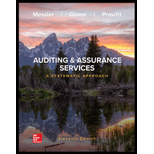
EBK AUDITING & ASSURANCE SERVICES: A SY
11th Edition
ISBN: 9781260687668
Author: Jr
Publisher: MCGRAW-HILL LEARNING SOLN.(CC)
expand_more
expand_more
format_list_bulleted
Concept explainers
Question
Chapter 16, Problem 16.26P
To determine
Introduction:The
To select: The audit procedure that the auditor most likely would perform to gather the supporting evidences.
Expert Solution & Answer
Want to see the full answer?
Check out a sample textbook solution
Students have asked these similar questions
Create financial forecasting years 2022, 2023, and 2024 using this balance sheet.
Beta Company Ltd issued 10% perpetual debt of Rs. 1,00,000. The company's tax rate is 50%.
Determine the cost of capital (before tax as well as after tax) assuming the debt is issued at 10 percent premium. help
Finance subject qn solve.
Chapter 16 Solutions
EBK AUDITING & ASSURANCE SERVICES: A SY
Ch. 16 - Prob. 16.1RQCh. 16 - Prob. 16.2RQCh. 16 - Prob. 16.3RQCh. 16 - Prob. 16.4RQCh. 16 - Prob. 16.5RQCh. 16 - Prob. 16.6RQCh. 16 - Prob. 16.7RQCh. 16 - Prob. 16.8RQCh. 16 - Prob. 16.9RQCh. 16 - Prob. 16.10RQ
Ch. 16 - Prob. 16.11RQCh. 16 - Prob. 16.12MCQCh. 16 - Prob. 16.13MCQCh. 16 - Prob. 16.14MCQCh. 16 - Prob. 16.15MCQCh. 16 - Prob. 16.16MCQCh. 16 - Prob. 16.17MCQCh. 16 - Prob. 16.18MCQCh. 16 - Prob. 16.19MCQCh. 16 - Prob. 16.20MCQCh. 16 - Prob. 16.21MCQCh. 16 - Prob. 16.22MCQCh. 16 - Prob. 16.23MCQCh. 16 - Prob. 16.24PCh. 16 - Prob. 16.25PCh. 16 - Prob. 16.26PCh. 16 - Prob. 16.27PCh. 16 - Prob. 16.28PCh. 16 - Prob. 16.29PCh. 16 - Prob. 16.30P
Knowledge Booster
Learn more about
Need a deep-dive on the concept behind this application? Look no further. Learn more about this topic, finance and related others by exploring similar questions and additional content below.Similar questions
arrow_back_ios
SEE MORE QUESTIONS
arrow_forward_ios
Recommended textbooks for you
 Auditing: A Risk Based-Approach (MindTap Course L...AccountingISBN:9781337619455Author:Karla M Johnstone, Audrey A. Gramling, Larry E. RittenbergPublisher:Cengage Learning
Auditing: A Risk Based-Approach (MindTap Course L...AccountingISBN:9781337619455Author:Karla M Johnstone, Audrey A. Gramling, Larry E. RittenbergPublisher:Cengage Learning Auditing: A Risk Based-Approach to Conducting a Q...AccountingISBN:9781305080577Author:Karla M Johnstone, Audrey A. Gramling, Larry E. RittenbergPublisher:South-Western College Pub
Auditing: A Risk Based-Approach to Conducting a Q...AccountingISBN:9781305080577Author:Karla M Johnstone, Audrey A. Gramling, Larry E. RittenbergPublisher:South-Western College Pub

Auditing: A Risk Based-Approach (MindTap Course L...
Accounting
ISBN:9781337619455
Author:Karla M Johnstone, Audrey A. Gramling, Larry E. Rittenberg
Publisher:Cengage Learning

Auditing: A Risk Based-Approach to Conducting a Q...
Accounting
ISBN:9781305080577
Author:Karla M Johnstone, Audrey A. Gramling, Larry E. Rittenberg
Publisher:South-Western College Pub
